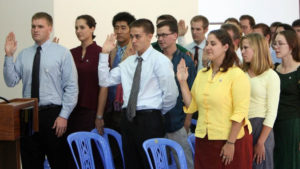Big data is Peace Corps’ ticket to renewed policy relevance (and mojo) (Malawi)
Thanks for the ‘heads up’ from Dan Campbell (El Salvador 1974-77)
•
Big data is Peace Corps’ ticket to renewed policy relevance (and mojo)
by Michael Buckler, opinion contributor — 01/10/19
The views expressed by contributors are their own and not the view of the hill
 Peace Corps Director Jody Olsen recently spoke at the Center for Strategic and International Studies about the future of the iconic agency under her watch. As a former Peace Corps teacher in Malawi (2006-08), I was struck by Director Olsen’s honesty regarding the agency’s need to “demonstrate results” in addition to sharing “wonderful” stories.
Peace Corps Director Jody Olsen recently spoke at the Center for Strategic and International Studies about the future of the iconic agency under her watch. As a former Peace Corps teacher in Malawi (2006-08), I was struck by Director Olsen’s honesty regarding the agency’s need to “demonstrate results” in addition to sharing “wonderful” stories.
Director Olsen framed Peace Corps as a “strategic point in longer-term development efforts,” with volunteers providing “data points” to development partners such as USAID. These words suggest a seismic shift for a staunchly qualitative agency searching for relevancy in an increasingly quantitative world. Director Olsen appeared to identify Congress as the catalyst: “the Hill says show me [results].” Whatever the impetus, this change is good.
Peace Corps always has done some things well. Its marketing game is formidable. Among organizations operating overseas, only Peace Corps provides the rigorous linguistic and cross-cultural toolkit needed to immerse in a foreign, high-poverty environment for two solid years. By applying these skills and living like locals, Peace Corps volunteers earn respect and belonging from underserved populations. No organization has a wider or deeper web of relationships in the developing world. Relationships matter.
Yet, some in Washington have questioned whether Peace Corps is a prudent use of taxpayer dollars. For starters, there is very little quantitative evidence that Peace Corps succeeds as a development intervention. Peace Corps also isn’t cheap at roughly $50,000 per volunteer per year, although that figure would likely drop if Peace Corps expanded its active volunteer roster. The figure also fails to account for what volunteers do after service. Nevertheless, certain members of the Washington intelligentsia have Peace Corps in their crosshairs.
Even prominent returned volunteers such as Brian Forde have raised concerns about the agency. Peace Corps has a digital problem, according to Forde, a former Obama official who served in Peace Corps Nicaragua. With developing countries rushing online, Forde called for a “digital Peace Corps” that leverages technology and private-sector partnerships to “empower communities across the globe.” Forde knows what he’s talking about, having founded Llamadas Heladas, a startup that eventually became one of the largest phone companies in Nicaragua by enabling customers to make international calls at a tenth of the price charged by established carriers.
Yet, Forde’s commentary begets a much larger conversation about Peace Corps’ role in the fourth industrial revolution — big data. About 7,000 in number, Peace Corps volunteers, scattered in far-flung places around the world, are uniquely situated to serve as last-mile data miners — collecting, sharing and analyzing original datasets for the benefit of local people. In Malawi, one volunteer could oversee data for 30 villages, allowing Peace Corps Malawi to serve a staggering 3,000 villages per year. While data can be political, Peace Corps could maintain its independence by targeting data that won’t invite controversy.
Data are valuable. Communities would benefit from data visualizations of their achievements and remaining challenges. University researchers would swoon. Peace Corps could share the data it collects in real time on digital maps to inform the decisions of host country governments, international development agencies, and nongovernmental organizations. With original data, Peace Corps could demonstrate some serious bang for the taxpayer’s buck in terms of causal impacts (e.g., 50 percent reduction in cholera), as opposed to banal outcomes of little substantive value (e.g., 20 people received a training). Currently, little impact evaluation is happening outside of targeted initiatives such as Stomping Out Malaria.
 This data-driven approach would boost the morale of volunteers. Imagine every volunteer finishing service with a basic understanding of how to use statistics and econometrics to crunch numbers. Peace Corps volunteers have spent too much time, often in vain, teaching people how to build fuel-efficient mud stoves. What would really excite them is figuring out whether mud stove trainings led to a statistically significant reduction in wood consumption and then sharing that knowledge to inform public policy. The data are there. The Peace Corps volunteers are there. Let’s put them together.
This data-driven approach would boost the morale of volunteers. Imagine every volunteer finishing service with a basic understanding of how to use statistics and econometrics to crunch numbers. Peace Corps volunteers have spent too much time, often in vain, teaching people how to build fuel-efficient mud stoves. What would really excite them is figuring out whether mud stove trainings led to a statistically significant reduction in wood consumption and then sharing that knowledge to inform public policy. The data are there. The Peace Corps volunteers are there. Let’s put them together.
It’s 2019. Soft skills instilled by Peace Corps are still invaluable. Yet, heartwarming anecdotes and good intentions no longer ensure Peace Corps’ relevance in a data-driven world. In addition to learning the local word for “mango” and the proper way to show respect to an elder, Peace Corps volunteers need to understand the Central Limit Theorem (look it up, it’s beautiful). Ignoring this reality will only bolster the false perception among some in Washington that Peace Corps has outlived its usefulness.
Michael Buckler is an attorney at the U.S. International Trade Commission in Washington, D.C., and co-founder of Village X, a direct-giving nonprofit that funds development projects chosen by villages in rural Malawi.
Read it at: https://thehill.com/opinion/technology/424466-big-data-is-peace-corps-ticket-to-renewed-policy-relevance-and-mojo
See the talk at: https://www.csis.org/events/future-directions-peace-corps

Could not agree more. Only that which you can measure, can you correct or continue to prove is valuable. Well spoken!
Every agency or organization is expected to produce quantitative results. Various “scientific” modalities exist: comparing results between have and havenots (but, how do you morally deprive one set of test subjects in order to make comparisons with another set of test subjects who receive a benefit, e.g. treating those with HIV/AIDS while depriving the control group of the same service to prove a treatment’s effectiveness?); measuring numbers served (people, host national organizations, etc., requiring “bookkeepers” to keep track; and if the bookkeepers have a vested interest in the outcome, how do we keep them honest?); asking opinions of a group or sample (as polls show, not all that reliable!) and whatever new “sexy” tool is developed to do so. First, anyone not liking an organization can always develop reasons why these tools do not measure up (one is entitled to their own opinions, but not their own facts), the data is disregarded because it does not serve pre-conceived ideas (Republicans believing in frugal government and then giving huge budget-busting tax breaks to their donors, or believing that these tax breaks create jobs, which had been shown since the Clinton Administration, to never work!).
With Peace Corps, like any human service, it is near impossible to control for all factors that effect quantitative outcomes. For example, do we defund early childhood programming because we have never been able to prove that it is effective (what about just parking kids so that parents can go to work?) A study published in 2015 showed that the cost of not providing children with education, health, etc. cost the nation over one trillion dollars in lost GDP: does anyone really care enough to do anything about depriving child? As Congressman Barney Frank stated, we care about life only until a person is born. In essence, how do you quantify the self-actualization that comes from service? Similarly, how would we measure any human’s contribution to the self actualization of those served?
Thank you to John for printing this article. Thank you to Michael Buckler for writing it. And thank you to both Kay Dixon and David Gurr for your thoughtful comments. The article is provocative. I wish it had been the opening “shot” at a Peace Corps sponsored conference in which Peace Corps staff attended and listened silently, while RPCVs spoke, agreed and disagreed.
There was a Peace Corps sponsored conference for RPCVs in 1965 and never repeated. The Conference to which Michael refers is what is wrong, in my opinion, with Peace Corps. It was not a “peace corps conference”. Rather, it was “about” Peace Corps and sponsored by the Center for Strategic and International Studies. The Director spoke “to” the audience and lectured about the future of Peace Corps. She was introduced by an RPCV, interviewed by an RPCV, and most of the audience was composed by RPCVs. When Volunteers come home, they are not invited to Peace Corps Washington to be debriefted and to educate staff about what they did and what they learned. That is another thing that is wrong with Peace Corps. RPCVs are encouraged to “tell” their “stories” to everyone else, except the only people who should hear them, don’t.
Two immediate comments – one to Michael and one to everyone. First, Michael…”Washington intelligentsia” is an oxymoran!
Now, for those of you who are interested in the Peace Corps’ use of the new “Mojo” data points. Let me give you an example:
“Goal Lead: Regional Directors (Africa Region; Europe, Mediterranean, and Asia Region; Inter-America and the Pacific Region)
Data Source: VRT reporting against post project frameworks
Calculation: The number of projects that meet the two thresholds for a “documented gain” on at least one
of the selected standard sector indicators used for this goal divided by the number of projects that include one or more of the selected standard sector indicators. The two thresholds are (1) at least 25 percent of the Volunteers assigned to the selected projects must report some results and (2) the combined total of all Volunteer results must be at least 25 percent of the annual target for the project.” https://s3.amazonaws.com/files.peacecorps.gov/documents/open-government/pc_strategic_plan_2018-2022-annual_plan_2019.pdf
And this means what?????
My mind is racing with more comment and analysis. My thanks to Michael was heartfelt because he has me thinking of so many things….which is exactly how RPCVs should impact each other.
Evidently, “Big Data” is the new “buz word. From the PA Times (PA=Public Administration):
https://patimes.org/big-data-and-ai-in-local-government/
Big Data and AI in Local Government
From the article:
“This article is the first in a series that will examine the roll Big Data and AI can play in improving local government management and ensuring the field’s continuing relevancy in an era of declining revenue and fewer skilled public administrators.”
and
“First, what do we mean when we say, “Big Data?” In his book Business Intelligence Strategy and Big Data Analytics, Steve Williams defines “Big Data” as “large amounts of rapidly generated pictures, video clips, location (geospatial) data, sensor data, text messages, document images, web logs, and machine data traditionally captured and used by social media and internet-based businesses and more recently being leveraged by early adopter mainstream businesses.”